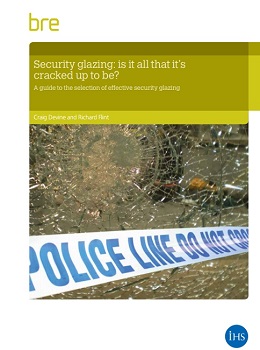Security glazing
In October 2016, BRE published the findings of a research project undertaken to investigate the performance and safety of glazing in security applications. The guide was primarily developed to help with the selection of effective security glazing.
The publication of ‘Security glazing: Is it all that it’s cracked up to be?’ (FB 55) followed a series of burglaries in London’s West End in 2008, ‘smash-and-grab’ attacks used to steal expensive goods from shop window displays.
The research explored the notion that, in some cases, glazing offered the least resistance to forced entry in situations where the generation of noise did not deter criminals. This premise was further demonstrated in the 2011 riots that hit major cities around the UK.
In addition to focusing on security, the research also examined an associated safety issue – that the majority of injuries from explosive events, including terrorist attack, invariably result from flying glass particles. Therefore, finding the correct specification of glazing to resist attack and reduce injury is vital.
The research uncovered a problem relating to the selection of an appropriate product to meet these dual requirements. A number of different glazing standards have been developed based upon specific test requirements. For example, glazing may be subject to a simulated manual attack or impacted by a known mass at a known velocity. However, the test results are not always directly comparable with those of tests conducted to other standards.
It is therefore useful to have an understanding of which standard is best suited to a particular application.
The types of glazing that the guide covers include:
- Acrylic.
- Fire-resistant glass.
- Float glass.
- Glass brick.
- Insulated glazing units.
- Laminated glass.
- Polycarbonate.
- Toughened glass.
- Wired glass.
The guide aims to assist architects, consultants, police officers and others who advise people on the selection of effective security. As well as focusing on physical security, particularly the resistance to manual attack of different glazing types, the guide also contains advice relating to other performance attributes.
You can download the guide from BRE Bookshop.
[edit] Related articles on Designing Buildings Wiki
- Annealing.
- BRE articles on Designing Buildings Wiki.
- Building fabric.
- CCTV.
- Electric lock.
- Embedded security: Procuring an effective facility protective security system.
- Fire detection and alarm systems.
- Glass.
- Glass block wall.
- Glass manifestation.
- Glazing.
- How to install an underfloor safe.
- Outbuildings security.
- Patent glazing.
- Perimeter security.
- Polycarbonate plastic.
- SABRE Security Assurance by the Building Research Establishment.
- Safety glass.
- Secondary glazing.
- Security and the built environment.
- Types and manufacture of laminated glass.
- Types of alarm.
- Types of lock.
Featured articles and news
Grenfell Tower Principal Contractor Award notice
Tower repair and maintenance contractor announced as demolition contractor.
Passivhaus social homes benefit from heat pump service
Sixteen new homes designed and built to achieve Passivhaus constructed in Dumfries & Galloway.
CABE Publishes Results of 2025 Building Control Survey
Concern over lack of understanding of how roles have changed since the introduction of the BSA 2022.
British Architectural Sculpture 1851-1951
A rich heritage of decorative and figurative sculpture. Book review.
A programme to tackle the lack of diversity.
Independent Building Control review panel
Five members of the newly established, Grenfell Tower Inquiry recommended, panel appointed.
Welsh Recharging Electrical Skills Charter progresses
ECA progressing on the ‘asks’ of the Recharging Electrical Skills Charter at the Senedd in Wales.
A brief history from 1890s to 2020s.
CIOB and CORBON combine forces
To elevate professional standards in Nigeria’s construction industry.
Amendment to the GB Energy Bill welcomed by ECA
Move prevents nationally-owned energy company from investing in solar panels produced by modern slavery.
Gregor Harvie argues that AI is state-sanctioned theft of IP.
Heat pumps, vehicle chargers and heating appliances must be sold with smart functionality.
Experimental AI housing target help for councils
Experimental AI could help councils meet housing targets by digitising records.
New-style degrees set for reformed ARB accreditation
Following the ARB Tomorrow's Architects competency outcomes for Architects.
BSRIA Occupant Wellbeing survey BOW
Occupant satisfaction and wellbeing tool inc. physical environment, indoor facilities, functionality and accessibility.
Preserving, waterproofing and decorating buildings.
























